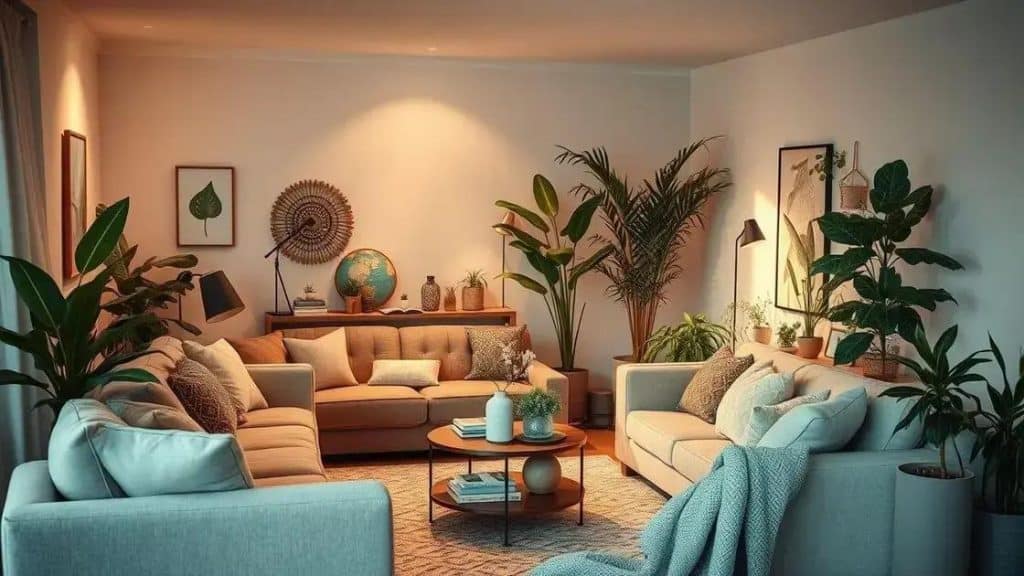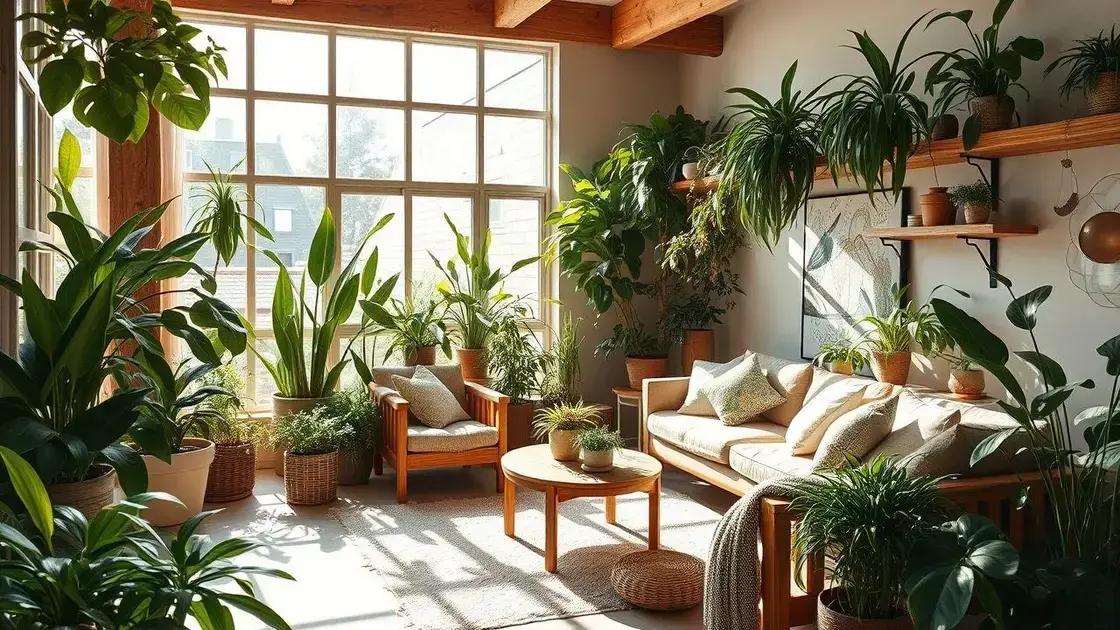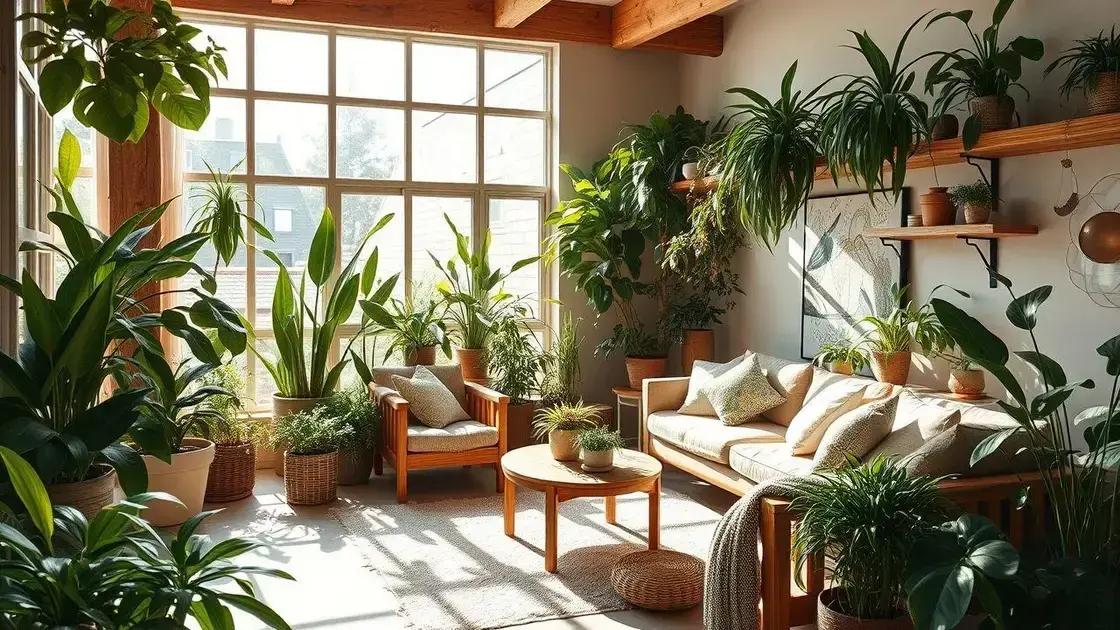Designing a calming living space to enhance your well-being

Designing a calming living space involves using soothing colors, incorporating natural elements, and creating functional areas that promote relaxation and peace of mind.
Designing a calming living space can transform your home into a sanctuary. Have you noticed how certain spaces instantly make you feel at ease? Let’s explore ways to enhance your living environment and elevate your well-being.
Understanding the principles of calming design
To design a calming living space, it’s essential to understand the principles of calming design. These principles guide how we can create environments that promote relaxation and peace. By focusing on elements that soothe the senses, we can transform our homes into havens.
Key Elements of Calming Design
Start with understanding the essential elements that contribute to a calming atmosphere. Incorporating these thoughtfully can significantly impact your space.
- Natural Light: Maximizing natural light helps to create a bright and inviting environment.
- Neutral Colors: Using a palette of soft, neutral colors can promote tranquility and reduce visual clutter.
- Simple Shapes: Opt for furniture and décor with simple, clean lines to avoid overwhelming the senses.
- Comfortable Textures: Incorporate soft fabrics and textures that invite relaxation.
Another vital aspect of calming design is the arrangement of space. Arranging furniture in a way that facilitates easy movement can make a room feel more welcoming. For instance, consider creating cozy conversational areas with well-placed seating.
In addition, decluttering your living space is crucial. A tidy environment is inherently more peaceful. Regularly removing items that don’t serve a purpose or bring joy can help maintain a serene atmosphere.
Incorporating Nature
Bringing nature indoors is a fantastic way to enhance your living space. Plants contribute fresh air and can uplift your mood. They can also serve as beautiful decor that integrates the outdoors with indoor living.
For example, consider placing a few indoor plants around your home. Plants such as peace lilies, snake plants, and pothos are easy to care for and help purify the air. Additionally, using natural materials like wood and stone in your décor can establish a connection to nature, further promoting relaxation.
Finally, consider the sounds in your environment. Soft background music or nature sounds, like flowing water, can enhance the calming effects of your space. Creating a peaceful auditory backdrop can help you unwind after a long day.
Incorporating natural elements for tranquility

Incorporating natural elements into your living space can greatly enhance tranquility. Nature has a calming effect on the mind and body, making it essential for a peaceful home environment. One of the simplest ways to bring nature indoors is through houseplants.
Benefits of Houseplants
Houseplants not only purify the air but also add life to your home. When choosing plants, consider those that require minimal maintenance, especially if you’re new to plant care.
- Snake Plant: This hardy plant is known for its air-purifying qualities and resilience.
- Pothos: An easy-to-grow vine that thrives in various light conditions.
- Peace Lily: Known for its beautiful white blooms and ability to filter toxins.
In addition to plants, natural materials such as wood and stone can create a warm and inviting atmosphere. Furniture made from reclaimed wood adds character and a sense of authenticity. The texture of natural stone can also contribute to a grounding feeling in your space.
Sound and Aroma from Nature
Another way to incorporate nature is through sound and aroma. Consider adding a small indoor water feature, such as a fountain. The gentle sound of flowing water can help drown out background noise and instill a sense of calm. Additionally, using essential oils or candles with natural scents like lavender or eucalyptus can enhance the peaceful ambiance. These scents are not only pleasant but also known for their relaxing properties.
Moreover, natural light plays a vital role in creating a soothing environment. Use light, sheer curtains to allow sunlight to fill your rooms. The warmth of sunlight can elevate your mood and create a brighter, more inviting space. Try to keep your windows clean and unobstructed to maximize that cheerful, illuminating energy.
Lastly, consider integrating outdoor views into your design. Position furniture to face windows that provide a view of nature. This connection to the outside world helps to ground you and can make you feel more at peace within your living space.
Choosing colors that promote relaxation
Choosing colors that promote relaxation is a vital part of designing a calming living space. Colors can greatly influence our emotions and mood. When selecting a color palette, it’s essential to focus on tones that evoke a sense of peace and tranquility.
Colors That Soothe the Mind
Soft and muted colors are the best options for creating a serene environment. Colors like blues, greens, and soft neutrals can help calm your mind and body. When these colors are used effectively, they can make a space feel more open and inviting.
- Soft Blue: This color is known for its calming effects, reminiscent of the sky and water.
- Pale Green: A gentle green reflects nature and can create a refreshing atmosphere.
- Warm Beige: This neutral color adds warmth without overwhelming the senses.
- Light Lavender: A soft lavender brings a hint of color while still feeling peaceful.
In addition to these colors, consider the lighting in your space. Natural light can enhance the appearance of colors, making them feel more vibrant and inviting. To maximize tranquility, use sheer curtains or light-filtering blinds that allow soft sunlight to enter.
The Psychology of Color
Understanding the psychology of color is also beneficial. Colors can trigger specific emotions, and using this knowledge in your home can enhance relaxation. For example, shades of blue are often associated with calmness and stability. In contrast, yellows and reds can be energizing and may not be suitable for a relaxing space.
When planning your color scheme, think about how each color makes you feel. It might help to create a mood board with paint samples, fabric swatches, and other decor to visualize how different colors work together. By doing so, you will create a cohesive look that resonates with your desire for peace.
Ultimately, the colors you choose should reflect your taste while promoting a sense of calm. Don’t shy away from using color, as it can significantly affect how you feel in your home. Careful selection and balance can lead to a living space that feels rejuvenating and restful.
Creating functional spaces for peace of mind

Creating functional spaces for peace of mind is essential in designing a calming living space. Every area in your home should serve a purpose while providing comfort and tranquility. Thoughtful design can improve functionality and enhance your overall well-being.
Designing Specific Areas
To start, it’s vital to identify key areas where functionality matters most. For instance, your living room should encourage relaxation and social interaction. Incorporate comfortable seating arrangements that invite conversation.
- Multi-functional Furniture: Use pieces that serve more than one purpose, such as a sofa bed or an ottoman with storage.
- Defined Zones: Create distinct areas for different activities, like reading, working, or playing.
- Natural Flow: Arrange furniture to allow easy movement, making the space feel open.
In addition to the living room, consider your bedroom. This space is where you should unwind and recharge. A clutter-free environment with essential items only promotes better sleep.
Practical Storage Solutions
Implementing practical storage can greatly reduce clutter and create a peaceful atmosphere. Utilize baskets, shelves, and structured closets to organize your belongings efficiently. This way, everything has a designated place, which makes it easier to maintain order.
It’s also helpful to integrate personalized touches that reflect your style. Hang calming artwork and incorporate decor that brings joy and comfort. Just make sure these elements don’t overcrowd the space. Finding the right balance between personal expression and minimalism is key.
Moreover, consider the use of light. Bright, well-lit areas can make rooms feel larger and more welcoming. Opt for warm-toned lighting and place lamps in areas needing extra illumination. Layering light sources can enhance the ambiance and create a cozy environment.
Finally, focus on keeping spaces adaptable. As your needs change, your home should be able to evolve with you. Choose furniture and layouts that can easily adjust to different lifestyles, promoting lasting tranquility.
Creating a calming living space requires careful consideration of various elements. By incorporating natural elements, selecting soothing colors, and designing functional areas, you can truly enhance relaxation in your home. Remember to focus on practicality, and aim for a harmonious environment that reflects your personal style. Each small change can contribute to a more peaceful atmosphere, making your home a serene retreat.
\n\n
\n
FAQ – Questions about designing a calming living space
What colors are best for creating a calming atmosphere?
Soft blues, greens, and neutral tones are ideal as they promote relaxation and peace.
How can I incorporate natural elements into my home?
Use indoor plants, natural materials like wood, and aim for natural light to bring the outdoors inside.
What furniture layout promotes tranquility?
Arrange furniture to create open pathways and define distinct areas for different activities, ensuring comfort and ease of movement.
What are some practical tips for decluttering my space?
Regularly remove items that are no longer needed, create designated places for belongings, and use storage solutions to keep surfaces clear.





